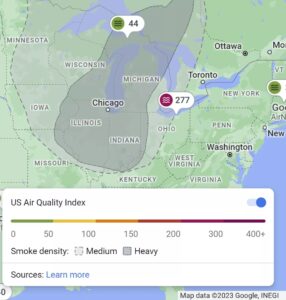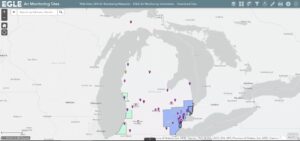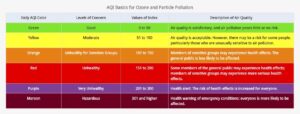
By Lester Graham, Michigan Radio
The Great Lakes News Collaborative includes Bridge Michigan; Circle of Blue; Great Lakes Now at Detroit Public Television; and Michigan Radio, Michigan’s NPR News Leader; who work together to bring audiences news and information about the impact of climate change, pollution, and aging infrastructure on the Great Lakes and drinking water. This independent journalism is supported by the Charles Stewart Mott Foundation. Find all the work HERE.
Smoke from Canadian wildfires is continuing to cause poor air quality in Michigan. Below you can find links to get the most up to date information from the U.S. Environmental Protection Agency (EPA) and the Michigan Department of Environment, Great Lakes, and Energy (EGLE).
There are also tips below from EGLE about what you can do to protect yourself or vulnerable people in your care.
The map at the top of the page reveals Michigan is experiencing poor air quality across the entire state. You can get updates here.
The map below is a clearer indication of where the plumes of smoke are located. As you can see, the heaviest smoke covers most of Michigan, but all of the state is experiencing poor air quality conditions. You can find this map here.

This map shows the extent and intensity of the smoke coming from Canadian wildfires. (Image courtesy of USEPA)
The EPA relies on EGLE air monitoring stations to update its maps. Below is a map of where those air monitors are located. Most of the monitors are in places (mostly urban centers) known to have air pollution problems such as ozone. Places that normally have few air pollution problems, such as the Upper Peninsula (where there’s one monitor), have fewer monitors. You can find this map here.

EGLE air monitoring sites. (Photo courtesy of EGLE)
You can get air quality information for your area from the EPA’s AirNow site by typing in the name of your city or zip code, such as the one below by using this link. This site is periodically updated for more than 500 cities in the U.S.

Photo courtesy of Lester Graham/ USEPA And Partners
The graphic below explains what the color coding for the Air Quality Index means.

Photo courtesy of Lester Graham
Tips for staying safe during an Air Quality Alert from EGLE:
- Sensitive groups, such as people with lung disease (including asthma), heart disease, and children and older adults, should limit prolonged or heavy exertion.
- Reduce or eliminate activities that contribute to air pollution, such as outdoor burning and use of residential wood-burning devices.
- Reduce vehicle trips and vehicle idling as much as possible.
- Keep windows closed overnight to prevent smoke from getting indoors and, if possible, run central air conditioning with MERV-13 (or higher)-rated filters.
EGLE also explains what the pollutants are and what health problems they could cause
- Fine particulate matter (PM-2.5) is made up of tiny liquid or solid particles with a diameter less than 2.5 micrometers. PM-2.5 is composed mainly of ammonium sulfate, ammonium nitrate, organic carbon, and smaller portions from elemental carbon and soil or crustal elements.
- PM-2.5 comes from a variety of sources included burning, fugitive dust, and biogenic sources (from plants).
- PM-2.5 can be emitted directly (primary) or react in the air to form particles (secondary).
- Respiratory and cardiac problems are directly linked to PM-2.5 exposure.
- Children, older adults, and people with heart or lung diseases are especially susceptible to the health effects from PM-2.5.
- Particulate matter can affect breathing and the defenses of the lungs, and aggravates existing respiratory and heart disease.
- More serious effects may occur depending on the length of exposure, the concentration, and the chemical nature of the particulate matter.
- Asthmatics and individuals with chronic lung and/or heart disease, people with influenza, the elderly, and children are the most susceptible.
- Fine particulate matter is especially problematic because it can penetrate deep into the lungs and remain there.
- Particulate matter is the major cause of reduced visibility in many parts of the United States. PM-2.5 is considered to be an important visibility-reducing component of urban and regional haze.
- Airborne particles can also impact vegetation and ecosystems and can cause damage to paints, building materials, and/or surfaces. Deposition of acid aerosols and salts may increase corrosion of metals and impact plant tissue by corroding leaf surfaces and interfering with plant metabolism.
Further information from EGLE can be found here.
Catch more news at Great Lakes Now:
Michigan under statewide advisory as Canada wildfire smoke hits Midwest
It isn’t arson: untangling climate misinformation around Canada’s raging wildfires
Featured image: This fire and smoke map is provided by the U.S. EPA and is updated periodically. You can find it at https://fire.airnow.gov/ (Photo courtesy of Lester Graham/ AirNow USEPA)




